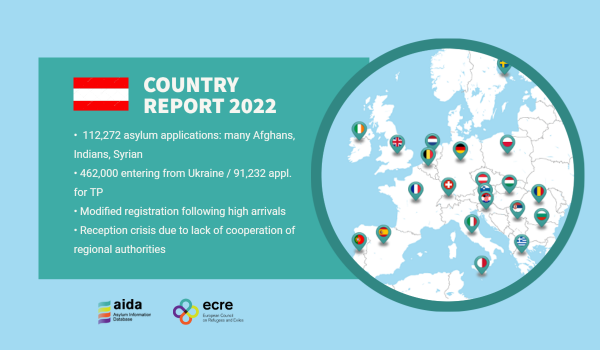The updated AIDA Country Report on Austria provides a detailed overview on legislative and practice-related developments in asylum procedures, reception conditions, detention of asylum seekers, the content of international protection, as well as the procedure for and content of temporary protection in 2022.
In 2022, a record 112,272 asylum applications were lodged in 2022. However, concurrently 42,000 cases were discontinued due to the onward travel of the applicants to other countries. Nationalities most represented among applicants were Afghans (25,038), followed by Indians (20,047) and Syrians (19,747). Applications from nationals from India, Tunisia and Morocco surged as a result of visa-free entry into Serbia and onward travel through Hungary. First and second-instance combined recognition rates stood at 38.5%, with the overturn rate of first-instance decisions before the court at the second instance increasing to 55% of all decisions challenged over 2022.
Meanwhile, in 2022 462,000 Ukrainians entered Austria, but 382,000 then left the territory. 91,232 persons were registered as displaced persons from Ukraine, among which 2/3 are female. 68,124 Ukrainians were registered in the Central residency registration system, of which approx. 50,000 receive basic care services. The scope of TPD applied in Austria is more restrictive than that of the EU Council Implementing Decision regarding third-country nationals: only family members and beneficiaries of international protection are eligible for temporary protection. The large number of arrivals early in the full-scale invasion led to a crisis of the already dysfunctional basic care system, under the responsibility of the provinces. Although Austrian basic care is mainly based on organised housing, most TP beneficiaries are accommodated in private housing (70% in January 2023).
The 2021 judgment ruling the pushbacks conducted by the Austrian Police unlawful was confirmed in the appeal. There were no reports of pushbacks by the Austrian authorities on Austrian territory in 2022. Due to the rise in arrivals at Austria’s easter border, the registration process was altered in Burgenland. After registration and fingerprinting, non-vulnerable applicants were dispersed to other regional police directorates and made to stay in waiting zones for their first interview. Reception conditions in these waiting zones were very poor and inadequate.
Asylum seekers experienced further issues in reception across the entire procedure. Indeed, federal reception centres, which should only accommodate asylum seekers during the admissibility phase, were overcrowded due to the lack of cooperation of the provinces, who are responsible for the accommodation of asylum seekers after the positive conclusion of the admissibility procedure. Only around 17,000 applicants were transferred to the provinces throughout the whole year. This notably resulted in up to 1,000 UAMs having to stay in inadequate reception centres for months. Asylum seekers had to be accommodated in tents to prevent homelessness until, as temperatures dropped and snow fell, public outrage led the authorities to find budlings to house the asylum seekers.
Austrian authorities initiated fewer withdrawal and cessation procedures in 2022, however, this is likely rather due to the high number of asylum applications rather than a change in policy. Concurrently, there was a sharp increase in successful naturalisation processes with over 2,000 beneficiaries of protection obtaining Austrian citizenship, mainly due to the expiry of the waiting time of Syrian nationals having received asylum status in 2015 and 2016.
For further information:
- Find comparative information in the Asylum Information Database (AIDA) managed by ECRE

